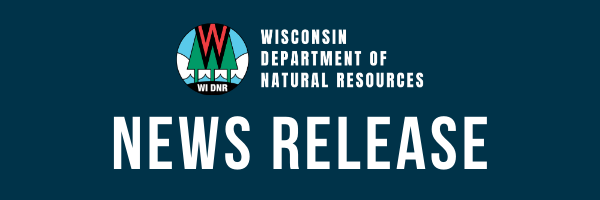|
FOR IMMEDIATE RELEASE: Feb. 1, 2021
Contact: Rich Staffen, DNR Conservation Biologist
Richard.Staffen@wisconsin.gov or 920-366-0372
Brenna Marsicek, Madison Audubon Society Communications Director
bmarsicek@madisonaudubon.org or 608-255-2473
Eagle-Eyed Wisconsinites Report
Dozens Of New Bald Eagle Nests

Bald eagle monitoring and protection efforts identified dozens of new bald eagle nests in 2020 . / Photo Credit: Wisconsin DNR
MADISON, Wis. – Eagled-eyed Wisconsinites reported dozens of new bald eagle nests in 2020, while volunteers from Madison Audubon Society monitored known nests from the ground in nine counties.
These collective volunteer efforts greatly helped the Wisconsin Department of Natural Resources’ (DNR) bald eagle monitoring and protection efforts in 2020 and are expected to do so again as bald eagles soon begin nesting in southern Wisconsin.
Documenting and surveying known bald eagle nest locations is important to track population trends. This allows DNR staff to provide current information to landowners and forest managers on nest locations so they can avoid disturbing the birds during breeding season.
“The word is out that we’re interested in learning about new nests,” said Rich Staffen, Conservation Biologist for the DNR Natural Heritage Conservation Program, who is responsible for occupied nest surveys in nine counties in south central and southwestern Wisconsin. “Since our last occupied nest surveys in spring 2019, for my region alone, I have gotten 44 new nest reports of likely bald eagles. These are from citizens or biologists and reported to me or Madison Audubon Society. Most have been verified as active bald eagle nests.”
Highlights from public reports – most of them in southern Wisconsin where bald eagles are rapidly claiming new territories [PDF] – included a second documented nest in Kenosha County and two new nests in Madison. Milwaukee County, the only county without a documented nest, nearly erased that goose egg in 2020 until a volunteer discovered a nest less than a quarter-mile outside the county line.
Several of the new reports came from landowners or outdoor enthusiasts who discovered nests. Others came from some of the 2,000 volunteers who helped the DNR and partners complete data collection in 2019 for the Wisconsin Breeding Bird Atlas II, a five-year statewide effort to document the abundance and location of Wisconsin’s nesting birds.
The DNR and Madison Audubon Society staff have confirmed many of the new nest reports or sent volunteers to check the nests and potentially add to the list for future monitoring.
Madison Audubon Society’s Bald Eagle Nest Watch Aids Monitoring Effort
Up to 15% of the new nests reported in southwestern Wisconsin were discovered by volunteers assigned to watch known nest sites for Madison Audubon Society’s Bald Eagle Nest Watch.
Currently in its fourth year, the Madison Audubon Society’s Bald Eagle Nest Watch program is increasingly important to monitoring and protecting Wisconsin bald eagles. The program is expanding into the Fox Valley through a partnership with Kaukauna’s 1000 Islands Environmental Center.
Audubon program coordinators work with the DNR to get the location and historical data they need to assign volunteers to survey the nests.
This year, nearly 200 Bald Eagle Nest Watch volunteers will monitor more than 60 nests in 14 Wisconsin counties, enabling the DNR to focus survey efforts along riverways and public lands, where nests can be harder to see from the ground.
Volunteers watch their assigned nest for one hour every week from early February, when eagles begin pairing up in southern Wisconsin, to June or July when young hatched during the spring are ready to leave the nest or fledge.
Volunteers also document human disturbances near nests that may impact the birds. The Bald Eagle Nest Watch has used information volunteers collected about disturbances to work with local landowners and governments to re-route trails and alter prescribed burns to reduce disturbances that can potentially cause bald eagles to abandon their nests.
“They are really filling a much larger role,” Staffen said. “They’ve been a huge help.”
How To Report A New Nest And Get Involved In Nest Monitoring
The public is encouraged to report nests that are in remote areas and appear to be new. People can report suspected new nests to the DNR through our eagle watching web page.
“You can look at the size of the nest to see if it’s a new pair,” Steffen said. “They add to the nest every year, so newer nests are smaller nests.”
The Bald Eagle Nest Watch website has additional information about the Audubon program and will provide updates on how the nests are doing throughout the season.
Once endangered, bald eagles have made a remarkable comeback in Wisconsin. DNR aerial surveys have shown numbers soaring from 108 occupied nests in the early 1970s to a record 1,695 in 2019, expanding to 71 of Wisconsin’s 72 counties.
The recovery of bald eagles was made possible by the national ban on the pesticide DDT, added protections under federal and state endangered species laws, river cleanups, public donations and monitoring by the DNR’s Natural Heritage Conservation program and partners. Wisconsin’s bald eagle license plate also celebrates this success and raises money to help drive the next conservation success.
Find more information about bald eagles in Wisconsin and opportunities to see them this winter in the wild and virtually, visit the DNR eagle watching web page.
|


















